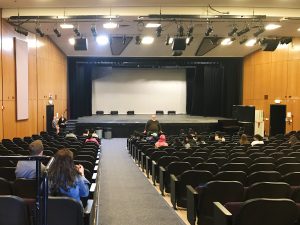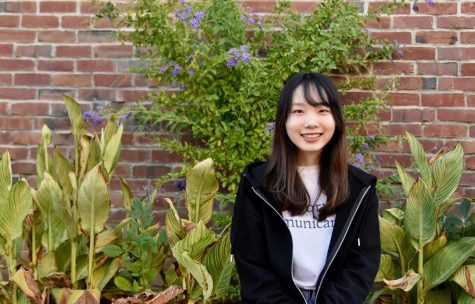Stanford counseling professionals hold presentation on stress and anxiety
April 1, 2018
On March 27 and 28, two Stanford postdoctoral counseling professionals, Michael Sasiain and Erica Jung, presented a workshop on stress and anxiety in the MVHS auditorium during lunch. The speakers emphasized the necessity of combating stress, as higher stress levels can lead to performance issues.
Although there were not many students that attended this presentation, sophomore Sophia Powell was among the attendees. When she received the schoolwide email with an invitation to listen to these speakers, she immediately decided to take part in the workshop.
“I just know how stressful MVHS can be and I just thought maybe I can get some insight on how I can relieve my stress,” Powell said.

According to Sasiain and Jung, there are three main ideas that are important in alleviating stress: the ability to control a situation, predict the future and use resources. Because stress is difficult to control, Sasiain and Jung emphasized the importance of maximizing resources. This can refer to accessing available information, getting support from other people and connecting with friends and teachers. To allow students to get a better understanding of these concepts, the speakers shared a short anecdote using a caveman and a sabertooth tiger.
“Picture yourself as a caveman. One evening you see a sabertooth tiger at the mouth of the cave. How stressful is that? Pretty stressful!” Jung said. “Picture a similar situation, but it’s not just you. It’s you and 20 of your closest friends who all have torches and spears. You’re significantly better equipped to handle that stress than when it’s just you in the dark with nothing.”
Jung also touched on the types and symptoms of stress. There can be a healthy stress that provides motivation to overcomes hardships, but there is also stress that can turn into anxiety and become a chronic issue. Stress affects thoughts and physical sensations and also incites feelings of fear, dread and nervousness. Jung explained that the most significant of these is fear.
“The biggest of these [emotions] is misplaced fear — the fear of something you’re not really sure is a threat,” Jung said. “The stress and anxiety from this fear may cause racing thoughts, almost as if you cannot keep up. There is an excessive worry. When you’re in a negative mindset, it can seem like everything is a source of worry.”
In addition to affecting our thoughts and emotions, stress can take a toll on our physical bodies. Physiological and biological side effects of stress include higher blood pressure, increased perspiration, tight muscles and a faster heart rate. All of these responses are a part of the body’s fight or flight response.
“It’s a really protective response, but it may not be so helpful if you’re trying to take a physics test or prepare for the SAT,” Jung said. “Many responses are involuntary, but it’s important to ask yourself, ‘Is my anxiety level helping me perform to my best or is it interfering?’”
Through the presentation, Sasiain and Jung conveyed various lessons regarding stress and anxiety to the students in the auditorium. Powell emphasizes that she felt that the speakers were helpful in providing insight on her stress levels.
“I thought it was really interesting. I really liked the caveman metaphor,” Powell said. “Overall, I thought the presentation was really helpful, and I’d definitely go again.”
Sasiain and Jung placed great emphasis on recognizing stress as well as reaching out to resources to help alleviate this stress.
“No stress is equal to higher performance,” Jung said. “That’s why it’s so important for high school students to reduce their stress levels.”



























